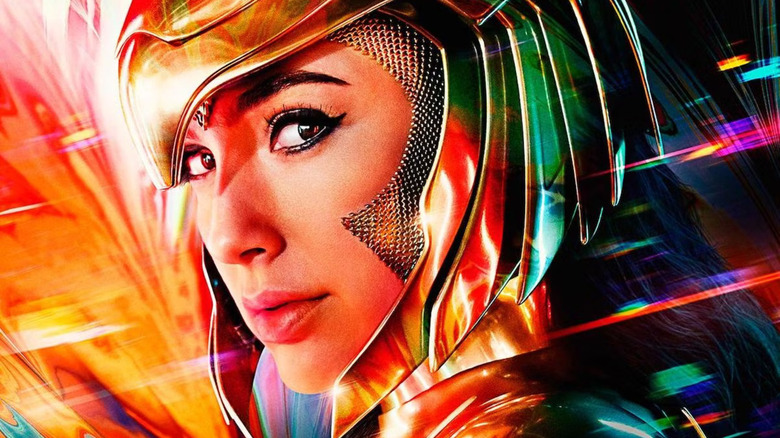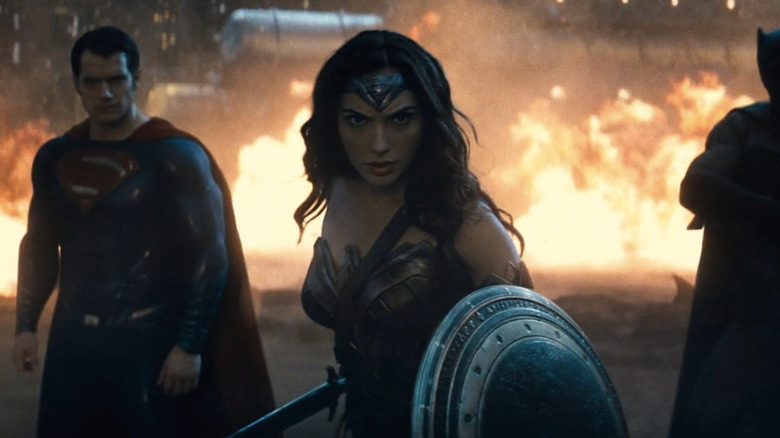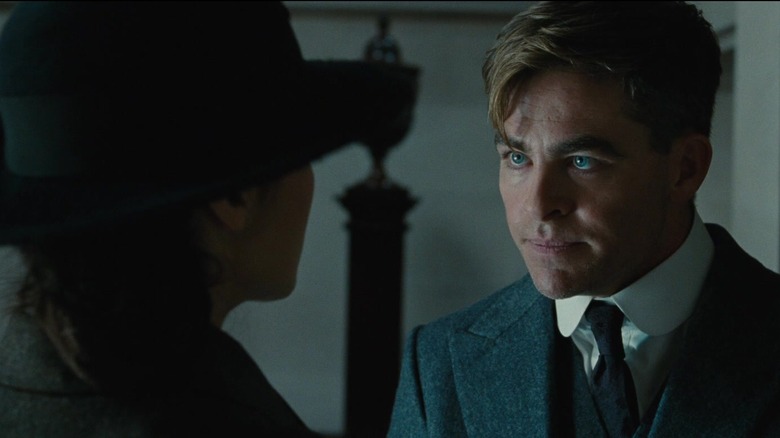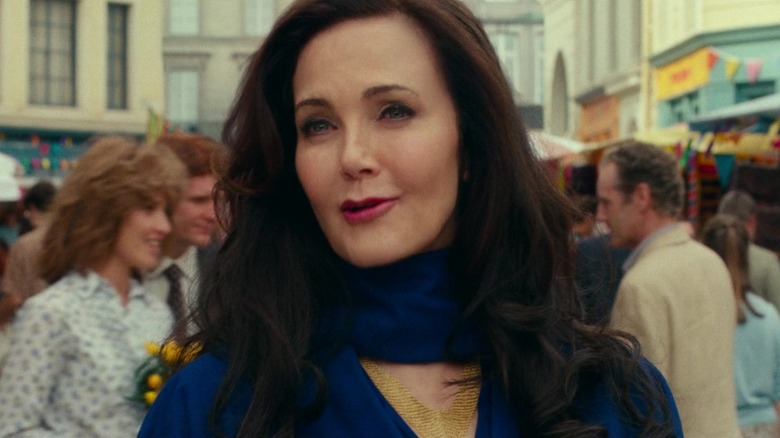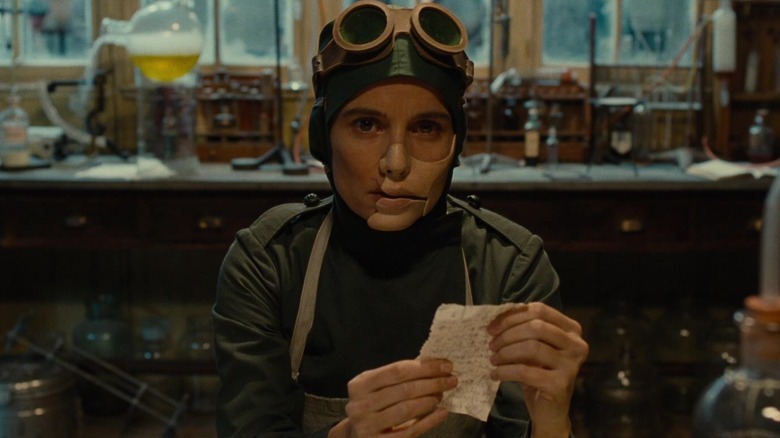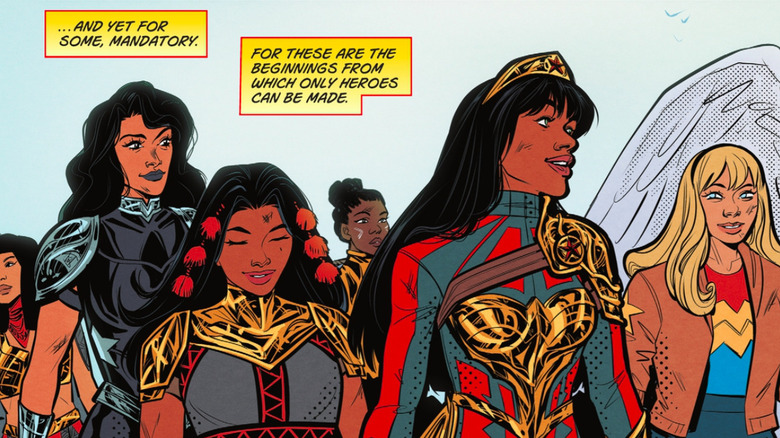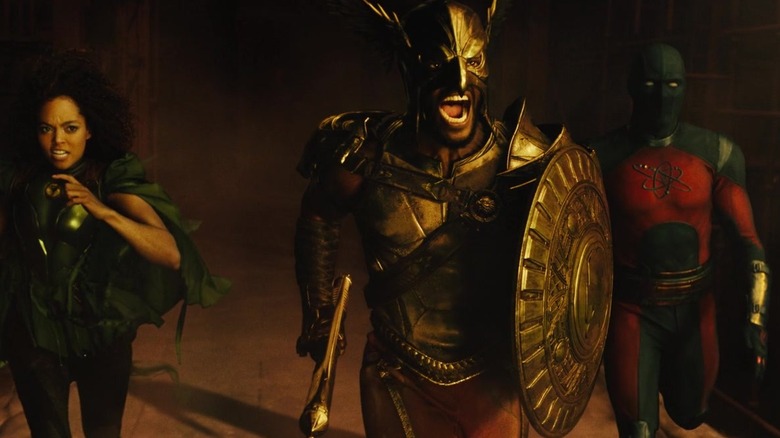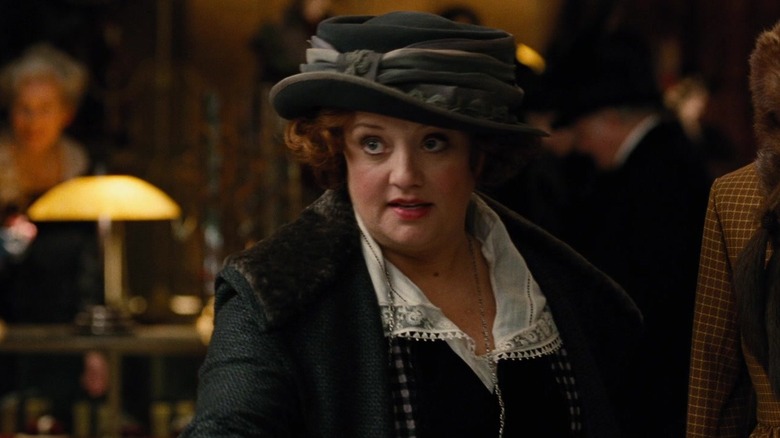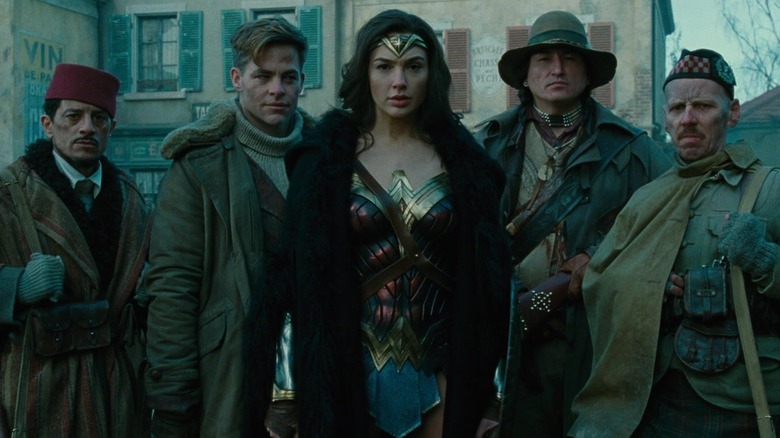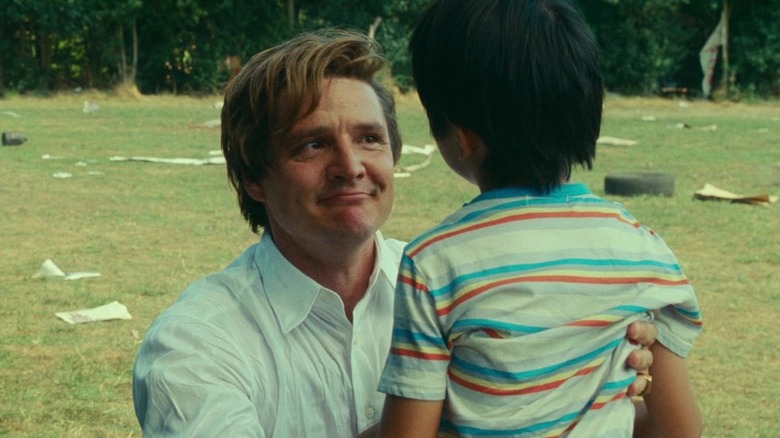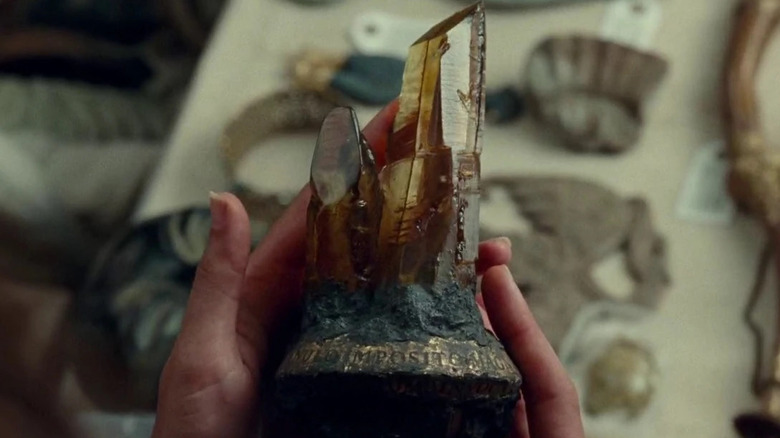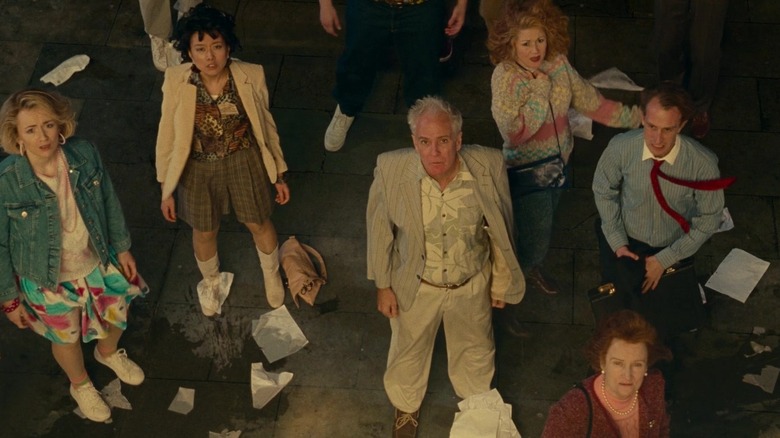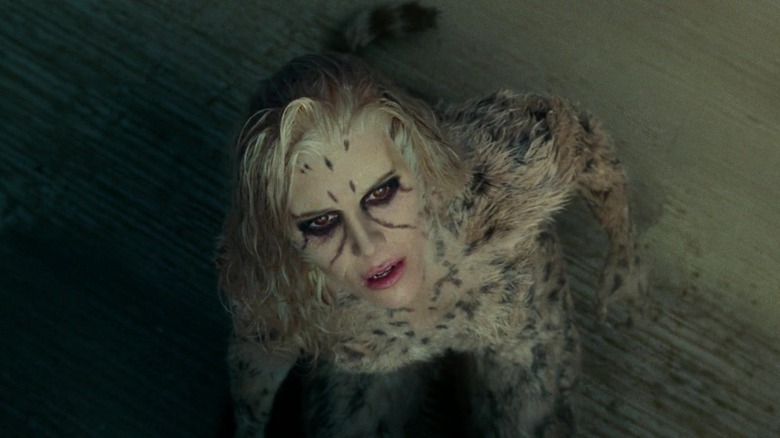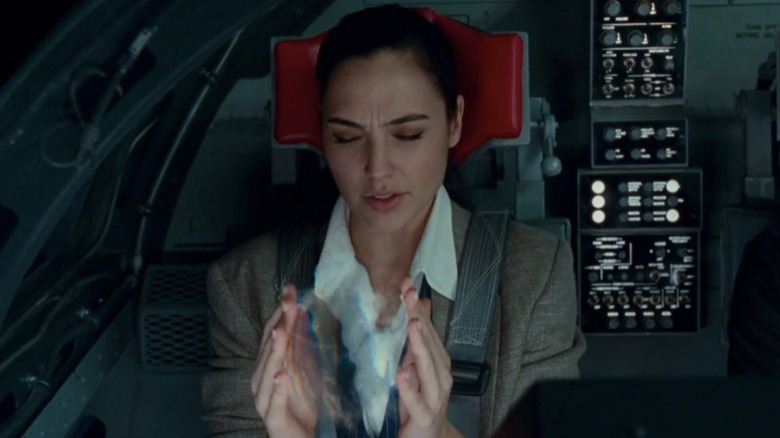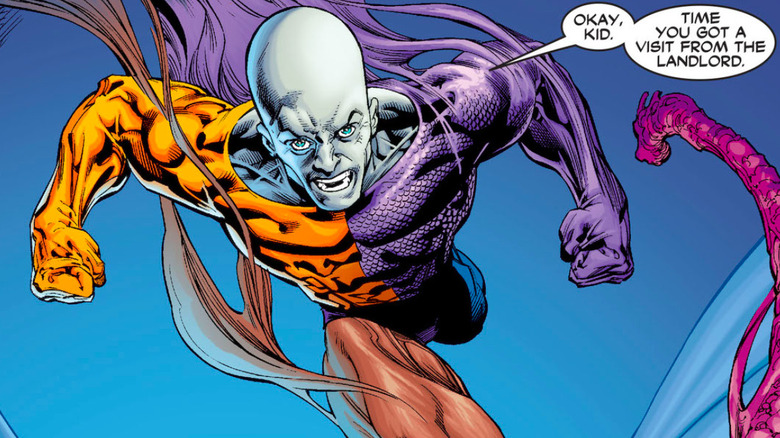14 Questions We Still Have About The DCEU Wonder Woman
It seems Wonder Woman aka Diana of Themyscira (Gal Gadot) will be hanging up her armor and weapons for now, at least in the DC Extended Universe. Despite a treatment for the film having recently been wrapped up, "Wonder Woman 3" won't be made after all, according to the Hollywood Reporter. The announcement is part of a general winding down of the DCEU, notes Variety, as DC Studios heads James Gunn and Peter Safran prepare to introduce their own DC cinematic universe.
The end of the DCEU Wonder Woman likely comes as souring news for many. Though reception toward the DC Extended Universe has been fairly mixed overall, the first "Wonder Woman" film in particular struck a chord with many, as its glowing Rotten Tomatoes scores and Hugo Award can attest. Seeing as "Wonder Woman 1984" left viewers with a cliffhanger of an epilogue, it seems the saga of the DCEU Diana will never get the conclusion its fans likely hoped for. Which, of course, means a lot of things will be left dangling. Just what plot points, danglers, and cliffhangers remain unresolved, you ask? Armor up and swing your Lasso of Hestia high one last time, as it's time to explore what questions about the Wonder Woman of the silver screen remain unanswered.
What was Diana up to between Wonder Woman 1984 and Batman v Superman: Dawn of Justice?
Since Wonder Woman's debut in "Batman v Superman: Dawn of Justice," the DCEU has been gradually filling in the backstory of its premier female hero. "Wonder Woman" reveals the character's origins as a superhero while telling the story behind the "BvS" photograph depicting her with several World War I soldiers, while "Wonder Woman 1984" fills viewers in on one of the Amazing Amazon's exploits during the world's most tubular decade. "1984" also provides certain details and hints as to what happens in the 66-year gap between the two movies.
Yet that still leaves a lot of ground uncovered, including what Wonder Woman was up to in the years between her second film and "Dawn of Justice." What sort of adventures did she go on? What lengths did she take to keep such a low profile? As the time gap between "Wonder Woman 1984" and "Dawn of Justice" is fairly substantial in itself, loads could have taken place during that period, some of which the third "Wonder Woman" movie would have surely addressed. For those eager to see how Wonder Woman fared in the decade of the Macarena (the '90s) or the early DVD era (the 2000s), they may just have to keep wondering.
Is Steve Trevor really gone for good?
American Expeditionary Forces pilot Steve Trevor (Chris Pine) is Diana's closest confidante in the first two "Wonder Woman" films. In the first, the Amazonian stops the remains of his wrecked plane from pulling him deep beneath the sea. The two go on a number of missions together during World War I's final days, sparking a romance along the way. Steve dies heroically halting a plane from bombing London with a deadly hydrogen-based mustard gas, but Diana accidentally resurrects him in another person's body in "Wonder Woman 1984." Though thrilled that Steve's back, Diana finds herself forced to part with him again when she discovers her wish comes with some adverse effects, namely gradually sapping her powers away.
Yet is that really the end for Steve Trevor? Some might argue resurrecting the character may lessen the impact of Diana's choice to place the world's needs over what she wants, along with Steve's satisfaction over her decision. Still, Trevor shares a special bond with Wonder Woman, and Diana trusts him more than virtually anyone. Perhaps the third "Wonder Woman" film might have had a cameo role in store for Steve, such as in flashback or in Wonder Woman's imagination. Or, as Trevor has alluded to spending time in some sort of idyllic afterlife before his resurrection, Diana could have visited that mysterious realm in the movie. Unless, of course, Steve's spirit unexpectedly detoured into the Greek Underworld and it's up to Diana to save him.
What would Wonder Woman's meeting with Asteria have been like?
As a child, Wonder Woman is told of Asteria, who long ago became revered among her fellow Amazons through her heroic deeds and honest nature. Many years later, Diana uses her Lasso of Truth to show Steve the full story, explaining that Asteria is the warrior who kept mankind from following the Amazons to Themyscira, apparently at the cost of her life. Not long thereafter, Wonder Woman follows in the mythic Amazon hero's footsteps by taking Asteria's armor into battle.
Surprisingly, however, Asteria appears alive and well during the mid-credits scene of "Wonder Woman 1984," played by the gold standard of live-action Wonder Woman stars, Lynda Carter. Which, as many have guessed, indeed would have set up a meeting between Asteria and Diana, as Gal Gadot confirmed to the Hollywood Reporter. Though that no longer seems destined to occur, one still can't help but wonder how exactly it might've have played out. Would Wonder Woman and Asteria have become instant friends and teamed up to battle a mutual enemy? Or would they have had a classic superhero misunderstanding before joining forces? Perhaps Asteria might have even been the "antagonist" of the movie, although her reputation and kind, grinning demeanor in "1984" certainly don't suggest malicious intentions. With luck, perhaps future live-action "Wonder Woman" films may bring back Gadot and Carter in special roles, perhaps allowing them to finally share time on-screen together in a Wonder Woman story, even if it's as different characters.
What other members of Wonder Woman's rogues' gallery exist in the DCEU?
As one might expect from a big-screen "Wonder Woman" adaptation, a few of Diana's major villains join her for the ride. The first movie brings in two of Wonder Woman's oldest enemies in the comics, Greek war god Ares (David Thewlis) and malevolent chemical genius Doctor Poison (Elena Anaya). "Wonder Woman 1984" dips into more modern waters by introducing the DC Extended Universe version of Diana's enemy since the 2000s, Maxwell Lord (Pedro Pascal), but also pulls from Wonder Woman's earlier comics by finally adapting her most well-known nemesis, the Cheetah (Kristen Wiig).
Which begs the question — who else? It'd be pretty shocking if the DCEU Wonder Woman avoided most of her comic book rogues' gallery during her 100-plus years as a superhero. It's true that Diana's unlikely to run into the other gods her comics counterpart has been known to face, like Circe and Hades, given that the first "Wonder Woman" movie claims Ares killed every deity of his pantheon. Still, not every Wonder Woman enemy from Greek mythology is a god, and Diana also has plenty of human super-foes. Given that the movies don't adhere 100 percent to the source material, perhaps Wonder Woman's already faced said villains over the decades. Was Giganta involved in animal rights extremism in the late 20th century? Could Doctor Cyber have been behind the 1970s plastic surgery boom? And did Doctor Poison's days of making chemical weapons really end after World War I?
Did Wonder Woman ever meet any of the Wonder Girls?
Most people have heard of Batman's famous teen crime-fighting partner in DC Comics, Robin. Not everyone knows, however, that Wonder Woman has also had young protégés on and off for more than half a century. The three most prominent are Donna Troy, Cassandra Sandsmark, and Yara Flor, who've all at one point used the same superhero identity "Wonder Girl." Donna was first, serving famously as an early member of the Teen Titans before eventually assuming various other superhero identities and roles. After her was Cassandra, who also became a Titan, as well as a member of fellow sidekick team Young Justice, and has led both groups. Finally, there's Yara, who currently shares the Wonder Girl identity with Cassandra and may even become Wonder Woman herself someday, as teased in the DC Comics event "Future State." Yara is unique among the Wonder Girls in that she also has powers and tools that stem from Brazilian deities and begins her superhero career before even meeting Wonder Woman or adopting a superhero name.
While Wonder Woman makes no mention in the DCEU of ever having worked with a Wonder Girl, that doesn't necessarily mean Diana hasn't met the three young women in some capacity. Perhaps they've helped her on missions while in civilian identities or have acted as costumed adventurers in an under-the-radar capacity, as Wonder Woman does for some time.
Has she met the Justice Society?
Wonder Woman is often depicted in the comics as having become a superhero during the Second World War. The DC Extended Universe, however, pushes her debut further back in time to the First World War. Similarly, while the movie "Black Adam" makes it clear that the Justice Society has been around for a while, it's never said for certain whether or not the team was originally formed during World War II, as it was in the comics.
What's still important, however, is that both Diana and the Justice Society have both been active before the formation of the Justice League. Which begs the question — have they ever had a team-up? In the comics, Wonder Woman actually is an honorary Justice Society member of the team during the Second World War, making an adventure, or series of adventures, with the Justice Society feel even more logical still. One can't deny that the idea of Wonder Woman teaming up with some of the longer-running members, like Doctor Fate (Pierce Brosnan), Hawkman (Aldis Hodge), and Henry Winkler's Al Pratt, could be pretty fun.
What sort of life did Etta Candy lead?
Apart from Steve Trevor, Etta Candy (Lucy Davis) is Wonder Woman's oldest non-superpowered ally in the comics, having first appeared back in "Sensation Comics" #2 just a little after Wonder Woman and Steve's debut. Etta appears in Wonder Woman's inaugural movie in the role of secretary to Steve Trevor, her razor-sharp wit from the comics pages fully intact. She very quickly gains a liking to Diana thanks to the Amazon's forward-thinking ways and helps Wonder Woman and the Wonder Men track down Gen. Erich Ludendorff (Danny Huston) and Doctor Poison's whereabouts with aid from Sir Patrick Morgan (also David Thewlis) — who, unbeknownst to anyone, is Ares in disguise.
"Wonder Woman 1984" shows Candy's association with Diana continued long after, as seen in a picture where Etta's on a field mission with Wonder Woman and the Wonder Men during World War II — not to mention another that shows Diana and Etta in more tranquil surroundings many decades after. That naturally raises a few questions, such as whether Etta became more involved in combat over time and what her military career post-World War I was like. Perhaps she chose another calling at some point after the Second World War, but continued to aid Wonder Woman on adventures, or at least keep in touch with her as a good friend.
What became of the Wonder Men?
Sameer (Saïd Taghmaoui), Charlie (Ewen Bremner), and Chief (Eugene Brave Rock) may not be the best fighters the Allies of World War I have to offer. Yet they are certainly the best Wonder Men a Wonder Woman could have by her side. Steve Trevor rounds up his old friends when he and Diana decide to foil the machinations of Doctor Poison and Gen. Ludendorff without the backing of most of Steve's superiors in London. Diana leads Steve and the other Wonder Men in freeing the fictional Belgian village of Veld from German occupation, after which the five catch up to Ludendorff, Doctor Poison, and the god behind it all, Ares.
Though they could not have scored the victories that they did without Wonder Woman, each member of the Wonder Men is remarkable in his own way. Not only that, but "Wonder Woman 1984" shows they were active during World War II, as seen in a photograph where they and Etta are liberating a concentration camp. Just how many more adventures did the gang go on together with Diana and Etta? And what did they do during peacetime? Perhaps Sameer fulfilled his dream of becoming an actor, for instance, or Charlie found treatment for his PTSD and took his song and piano routine on the road. "Wonder Woman 3" could have been an opportunity to shed more light on what became of the characters and even introduce some of their descendants.
What happened to Maxwell Lord and his son after Wonder Woman 1984?
In "Wonder Woman 1984," Maxwell Lord turns his flailing oil company around when he takes the Dreamstone from Barbara Minerva's (Kristen Wiig) office. Rather than simply ask for wealth and success, Lord requests that he become the actual Dreamstone. While that doesn't happen in the literal sense, he does gain the stone's powers, which he uses to enhance his status by making the wishes of people all over the world come true. Yet every wish he grants comes with a steep price, and Maxwell brings the world to the verge of armageddon until the sight of Alistair (Lucian Perez), his son, in potential peril convinces him to relinquish his special abilities.
While Maxwell's the film's major antagonist, he's not as malicious as one might expect. Furthermore, his last scene suggests he's truly learned his lesson and may walk a more altruistic path going forward. Naturally, there are a lot of roads he could take, including some straight from the comics. Lord could form a version of the Super Buddies from "Formerly Known as the Justice League," for example, which would open the door for fan favorites like Blue Beetle, Booster Gold, Fire and Ice to make their DCEU debut. Alternatively, he could create his Super Friends-inspired team from the "Justice League Unlimited" cartoon, the Ultimen. Or he could just focus on raising his son, which raises the question of what kind of person Alistair will become through Maxwell and his ex-wife's parenting.
Who has the Dreamstone now?
To say the Dreamstone is a coveted artifact in the DC Extended Universe is an understatement. As "Wonder Woman 1984" reveals, many individuals throughout human history have wielded it, only to unintentionally leave civilization in ruin as a result. Though a number of people use the stone in "1984," its primary owner is Maxwell Lord, who causes the stone to crumble into dust when he asks to take its place.
Since Lord eschews his massive power, however, it's certainly possible that the Dreamstone pieced itself back together. While no one is shown to come into possession of it afterward, the item rarely stays without an owner for long. Could the Dreamstone, for instance, eventually come into possession of Doctor Destiny, the Justice League villain most associated with the stone in the comics, or Morpheus, the protagonist of Neil Gaiman's "Sandman" series? After all, though the duplicitous deity Dechalafrea Ero (aka DC Comics villain the Duke of Deception) is the one who made the stone in the DC Extended Universe, its creator in the comics has been said to be Destiny and Morpheus at varying points. And just because neither character is behind the stone's making in the DCEU doesn't mean they wouldn't want their hands on it.
Did everyone on Earth renounce their Dreamstone wish?
Maxwell Lord manages to grant a lot of people wishes in a very short time. Yet the number of people whom Lord uses his powers on increases astronomically once he uses government technology to broadcast himself across many television stations. Each person who gets their wish granted, however, learns the hard way that getting what they want from Maxwell has some unwanted repercussions. It's only until Diana shows them how far those repercussions go with her Lasso of Truth that the people who asked Lord for a wish decide to give it up, just barely avoiding the mutual destruction of the United States and the USSR in the process.
While it's implied the vast majority requested that their wish be undone, perhaps a few decided that losing their greatest desire was too high a cost in itself. It's likely, for example, that a few used their wishes for a genuinely good cause, and that reversing them could be pretty dire in itself. Alternately, perhaps some folks with a greedy streak decided that not even borderline atomic destruction is worth returning what Lord gave to them. Perhaps that might include a few familiar faces from Wonder Woman's pool of villains?
Does the Cheetah still have some powers left?
There is one person who viewers know for a fact did not take back her wish. That person is Barbara Minerva, who makes her Dreamstone wish shortly after meeting Diana, desiring all the qualities she perceives within the Themysciran champion. The effects are almost immediate, as people begin immediately gravitating toward her the way they do Wonder Woman. Not to mention the wish is interpreted quite literally, as Minerva even gains strength comparable to Wonder Woman's.
Maxwell Lord later gives Barbara an upgrade when he begins granting wishes to everyone on Earth near a television set, using the price each must pay for their wish to turn Barbara into an even stronger cheetah-like humanoid. Barbara's tenure as the Cheetah, however, is pretty short, as she returns to her original appearance after the world renounces their wishes. However, Barbara does not relinquish hers. Could this mean she still has the magnetism and physical might said wish gave her?
Does Wonder Woman ever master invisibility?
Aside from her lasso, bulletproof bracelets, and boomerang-like tiara, the Invisible Jet is likely the most well-known tool in Wonder Woman's arsenal. Though the explanation for how the jet can hide completely from sight has varied across several media, "Wonder Woman 1984" establishes that in DCEU, it's Diana who can make the plane invisible. While attempting to take off from a runway without being arrested, Wonder Woman uses powers of invisibility inherited from her father, Zeus, to completely obscure the jet and its passengers — Diana and Steve Trevor — from all forms of detection, radar included.
Though Wonder Woman has only successfully wielded her invisibility powers twice, mastering the skill would make it an even greater asset. She could use it on herself and her allies, e.g. her fellow Justice Leaguers, so they can sneak up on any enemy, for instance, or pull off infiltration missions with ease. Diana could also use it to secretly carry her weapons while in civilian attire, which certainly would have made hiding them in the first "Wonder Woman" movie much easier.
Did she ever meet Metamorpho?
Maxwell Lord's company at the start of "Wonder Woman 1984," Black Gold Cooperative, is little more than empty office space and Maxwell himself, along with his two secretaries. It does, however, start out with an investor, namely Simon Stagg (Oliver Cotton), who's less than pleased by Lord's failure to generate the success he keeps promising. As a result, Stagg humiliates Lord by exposing him as a fraud in front of Alistair. Not one to let such an affront go unaddressed, Lord pays Simon a little visit after acquiring the power of the Dreamstone, tricking Stagg into wishing for Black Gold's success. As Maxwell also has the power to decide what price a person must pay for requesting a wish of him, Lord uses the opportunity to "reward" Stagg by having the FBI take Simon into custody, allowing Maxwell to seize both Stagg's shares and whatever power he had at Black Gold.
While Simon Stagg doesn't appear again in the movie, he's a pretty notable character in the comics, though not necessarily because of Wonder Woman. Instead, Simon is the archenemy of Metamorpho, the Element Man. No reference is made to Metamorpho in the movie, but that doesn't mean his alter ego, Rex Mason, isn't out there somewhere in the DCEU — the same can be said of Simon's daughter, Sapphire, whom Simon loves as much as he hates Mason for dating (and in the comics, eventually marrying) her. Perhaps at some point after "Wonder Woman 1984," Simon would have turned Rex into Metamorpho like in the comic books, possibly giving Wonder Woman a new ally in her pursuit of justice. With a new chapter starting at DC, anything is possible, but as far as Gadot's Wonder Woman is concerned, we may have seen the last of her Amazonian adventures.
